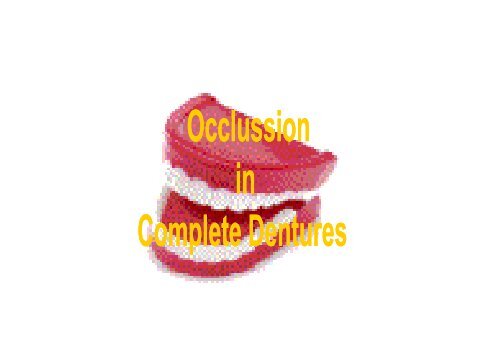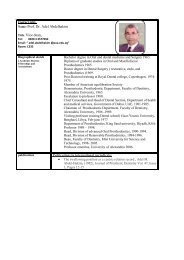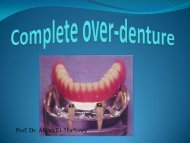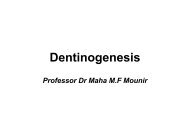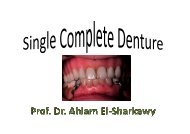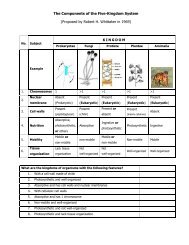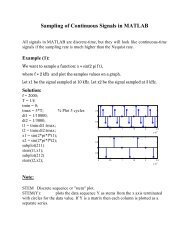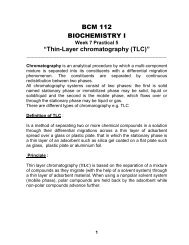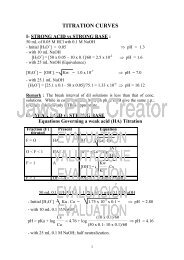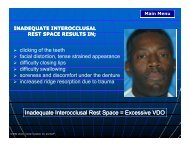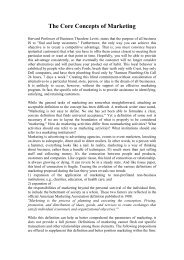You also want an ePaper? Increase the reach of your titles
YUMPU automatically turns print PDFs into web optimized ePapers that Google loves.
Introduction<br />
• Occlude means to ‘to close’.<br />
• Definition: ‘ Any contact between the incising or<br />
masticatory surfaces of the maxillary and<br />
mandibular teeth’ is termed as <strong>occlusion</strong><br />
• Complete denture must meet three major needs<br />
a). Comfort<br />
b). Function<br />
c). Esthetics
– Occlusion deals with the<br />
static relationship of<br />
the opposing teeth while<br />
articulation deals with<br />
the dynamic relationship<br />
of the opposing teeth.<br />
• Occlusion is an important<br />
factor that governs the<br />
stability and retention of<br />
the complete denture.
Important differences between<br />
natural and artificial <strong>occlusion</strong><br />
• Natural teeth<br />
function<br />
independently and<br />
each tooth<br />
disperses the<br />
occlusal load.<br />
• Proprioceptive<br />
impulses from<br />
peridontium avoid<br />
the occlusal<br />
prematurities<br />
• Artificial teeth<br />
function as a group<br />
and occlusal loads<br />
are not individually<br />
managed.<br />
• There is no<br />
feedback & the<br />
denture rests in<br />
centric relation.Any<br />
prematuries can<br />
shift the base
• Mal<strong>occlusion</strong> can be<br />
nonproblematic for<br />
yrs.<br />
• Non vertical forces<br />
are well tolerated.<br />
• Bilateral balance is<br />
not necessary &<br />
usually considered a<br />
hindrance<br />
• 2nd molar favored<br />
for mastication owing<br />
to leverage & power.<br />
• Mal<strong>occlusion</strong> pose<br />
immediate drastic<br />
problems.<br />
• Non vertical forces<br />
damage the<br />
supporting tissues.<br />
• Bilateral balance is<br />
mandatory to<br />
produce stability<br />
of the denture.<br />
• Heavy pressure on<br />
the 2nd molar will<br />
tilt the base on<br />
inclined foundation
TERMINOLOGY<br />
• OCCLUSION: static relationship b/w incising or<br />
masticating surfaces of maxillary or mandibular<br />
teeth or tooth analogues<br />
• ARTICULATION: contact relationship b/w occlusal<br />
surfaces of teeth during function<br />
• CENTRIC OCLUSION: <strong>occlusion</strong> of opposing teeth<br />
when mandible is in centric relation<br />
-May or may not coincide with maximum<br />
intercuspation
• MAXIMUM INTERCUSPATION: complete<br />
intercuspation of opposing teeth independent of<br />
condylar position<br />
• EXCURSIVE MOVEMENT: movement occuring<br />
when mandible moves away from maximum<br />
intercuspation<br />
• ECCENTRIC: any position of mandible other than<br />
that which is its normal position<br />
• ECCENTRIC OCCLUSION: any <strong>occlusion</strong> other than<br />
centric <strong>occlusion</strong>
BALANCING SIDE/NON-WORKING SIDE:<br />
That side of mandible which moves towards median<br />
line in lateral excursion<br />
BALANCING INTERFERENCES: undesirable contacts<br />
of opposing occlusal surfaces on non working side<br />
BALANCED OCCLUSION: Bilateral, simultaneous,<br />
anterior & posterior occlusal contacts of teeth in<br />
centric, eccentric positions
Ideal requirements of complete denture<br />
<strong>occlusion</strong><br />
1). Stability of the denture & its<br />
<strong>occlusion</strong> when the mandible is in<br />
both centric & eccentric relations.<br />
2).Balanced occlusal contacts.<br />
3).Unlocking the cusps mesiodistaly so<br />
that the denture can settle down when<br />
there is ridge resorption.<br />
4).Functional lever balance should be<br />
obtained by vertical tooth to ridge<br />
crest relationship.
5)Cutting, penetrating and shearing<br />
efficiency of occlusal surface.<br />
6). Minimal area of contact.<br />
7). Incisal clearance during posterior<br />
functions.<br />
8). Sharp ridges, cusps & sluiceways to<br />
increase masticatory efficiency.
Sears axioms of complete denture<br />
<strong>occlusion</strong>.<br />
è Smaller the area of the <strong>occlusion</strong> surface,<br />
the lesser is the amount of occlusal load<br />
transmitted to the supporting structures.<br />
è Vertical forces on a tilted occlusal surface<br />
will produce non-vertical forces on the<br />
denture.<br />
è Vertical forces on the denture base lying<br />
over the resilient tissues will produce<br />
lever forces on denture.<br />
è Vertical forces acting outside the ridge<br />
crest will produce tipping of the denture
Occlusal scheme requisites.<br />
Occlusal O scheme has three characteristics<br />
1). Incising units<br />
2). Working units<br />
3). Balancing units<br />
1). Incising units- includes all the four<br />
incisors.<br />
(a).sharp units for improved incising<br />
efficiency.<br />
(b). The unit should not contact during<br />
mastication except during protusion.
c). Shallow incisal guidance.<br />
(d). Increased horizontal overlap to avoid<br />
interference during settling.<br />
2).Working units- includes the canine s &<br />
the posterior teeth of the side towards<br />
which the mandible moves.<br />
(a). Cusps for good cutting.<br />
(b). Smaller buccolingual width to<br />
decrease the occlusal load.<br />
(c). Group function at the end of chewing<br />
cycle in eccentric positions.
(d). The occlusal load should be<br />
directed to the anterioposterior<br />
center of the denture.<br />
(e). Plane should be parallel to mean<br />
foundation of the ridge.<br />
3non-working Units- includes canines &<br />
posterior teeth opposing the working side.<br />
(a). The second molars should be contact<br />
during protrusion.<br />
(b). They should contact the working side<br />
at the end of chewing cycle.<br />
(c). Smooth gliding contacts.
1). BALANCED OCCLUSION<br />
Reported by Brewer.<br />
Definition: The simultaneous contacting of<br />
maxillary and mandibular teeth on right and<br />
left and in the posterior and anterior<br />
occlusal areas in centric and eccentric<br />
positions.<br />
Significance:Normal individual makes<br />
masticatory tooth contact only for 10 mins<br />
in one day compared to 4hrs of total tooth<br />
contact during other functions. So, for<br />
these 4hrs of tooth contact, <strong>balanced</strong><br />
<strong>occlusion</strong> is important to main denture<br />
stability.
Objectives of <strong>balanced</strong> <strong>occlusion</strong><br />
1).To improve the stability of denture.<br />
2). To reduce resorption of the residual<br />
ridge and soreness.<br />
3). To improve oral comfort & well being<br />
of the patient.
ADVANTAGES OF BALANCED OCCLUSION<br />
SWALLOWING-<br />
Bilateral balance allows contacts occuring during<br />
swallowing to be made evenly wihout displacing<br />
base against oral mucosa<br />
CHEWING- helps to seat denture in stable position<br />
during terminal arc of closure
PARAFUNCTIONAL MOVEMENTS:<br />
Balanced <strong>occlusion</strong> prevents destructive lateral<br />
forces generated against basal seat during<br />
parafunctional activity<br />
CHRISTENSEN PHENOMENON:<br />
if dentures are not <strong>balanced</strong> in protrusive<br />
excursion, resulting posterior dis<strong>occlusion</strong> &<br />
pressure in premolar area causes dislodgement
General considerations for <strong>balanced</strong><br />
<strong>occlusion</strong><br />
• The wider and larger the ridge & the<br />
teeth closer to the ridge, the greater<br />
the lever balance.<br />
• Wider the ridge &narrower the teeth<br />
buccolingually, greater the balance.<br />
• The more lingual the teeth are placed in<br />
relation to the ridge crest, the greater<br />
the balance.<br />
• The more centered the force of<br />
<strong>occlusion</strong> anteriopsosteriorly, the greater<br />
the stability of the base.
Lever balance<br />
• This is present when there is equilibrium on<br />
the supporting structures when a bolus of<br />
food between the teeth on one side and a<br />
space exists between the teeth on the<br />
opposite side
This state of equilibrium is encouraged<br />
by the following:<br />
• Having the denture base cover as wide an area<br />
on the ridge as possible.<br />
• Placing the teeth so that the resultant<br />
direction of the force on the functional side is<br />
over the crest of the ridge or slightly lingual to<br />
it.<br />
• Placing the teeth as close to the ridge.<br />
• Using as narrow bucco-lingual width occlusal<br />
table.
Types of <strong>balanced</strong> <strong>occlusion</strong><br />
1).Unilateral <strong>balanced</strong> <strong>occlusion</strong>:<br />
Type of <strong>occlusion</strong> when occusal surfaces of<br />
teeth on one side occlude simultaneously, as<br />
a group, with a smooth uninterrupted glide.<br />
2). Bilateral occlusal balance type of <strong>occlusion</strong><br />
seen when simultaneous contact occurs on<br />
both the sides in centric and eccentric<br />
positions.<br />
For minimal occlusal balance,<br />
there should be atleast<br />
3 point contact on occlusal<br />
plane (2 posterior & 1 anterior).
a). Protrusive occlusal balance<br />
Usually seen during the protrusion of<br />
the mandible.<br />
Factors governing protrusive balance:<br />
F Inclination of condylar path<br />
F Angle of incisal guidance.<br />
F Angle of the plane of <strong>occlusion</strong>.<br />
F Compensating curves.<br />
F Cuspal height & inclination of the<br />
posterior teeth.
).Lateral occlusal balance :<br />
Minimal 3 point contact during lateral<br />
moment of the mandible.Absent in normal<br />
dentition.If allowed while tooth<br />
arrangement then the denture would loose<br />
its stability due to lever action.<br />
Factors :<br />
F Angle of inclination of condylar path.<br />
F Angle of incisal guidance.<br />
F Angle of inclination of plane of <strong>occlusion</strong><br />
F Compensating curves.<br />
F Buccal & lingual cusp height.<br />
F The Benett side shift on the working side.
5).Hanua’s Quint- Rudolph proposed nine<br />
factors that govern articulation of artificial<br />
teeth<br />
Condylar<br />
guidance<br />
Incisal<br />
guidance<br />
Compensating<br />
curves<br />
Relative cusp<br />
height<br />
Plane of<br />
orientation<br />
www.rxdentistry.blogspot.com
• Shallow cusp teeth allow<br />
the opposing members to slide during<br />
mastication<br />
Higher cuspal angle lock the teeth<br />
• denture with steep<br />
incisal guidance<br />
tend to get displaced<br />
denture with shallow<br />
incisal guidance produce<br />
less interference
Shallow condylar guidance<br />
produces lesser tooth<br />
separation during<br />
protrusion<br />
•<br />
shallow incisal guidance<br />
lesser posterior teeth<br />
separation
posterior tooth<br />
separation during<br />
protrusion can<br />
be decreased by<br />
increasing the curve<br />
of spee.<br />
Plane of orientation can<br />
Plane of orientation can<br />
also be altered to<br />
decrease the posterior<br />
tooth separation during<br />
protrusion.
Mechanics of <strong>balanced</strong> <strong>occlusion</strong><br />
In natural teeth when the<br />
mandible is protuded so that<br />
the incisal edges of the<br />
upper & the lower teeth<br />
contact, there is a gap<br />
between the upper & lower<br />
posterior teeth, this is<br />
termed as “Christensen’s<br />
phenomenon”.
Y But this <strong>occlusion</strong> could<br />
cause tipping of the<br />
denture in the posterior<br />
region. Thus<br />
simultaneous anterior &<br />
posterior contacts are<br />
required when<br />
mandible is protruded.
Factors influencing <strong>balanced</strong> <strong>occlusion</strong><br />
(1) Inclination of the condylar path.<br />
(2). Incisal guidance.<br />
(3). Orientation of the plane of <strong>occlusion</strong><br />
(4). Cuspal angulation.<br />
(5). Compensating curve.<br />
When patients with steep incisal guidance<br />
brings his mandible forward, the<br />
movement is controlled by the lingual<br />
surface of upper anteriors thus leading<br />
to the lifting of the posterior part of<br />
denture . To prevent this other three<br />
components have to be modified
A). Incisal guidance B). Condylar guidance<br />
C). Cuspal angulation D).plane of <strong>occlusion</strong><br />
E). Compensating curve. A balance of these<br />
five factors is required for <strong>balanced</strong><br />
<strong>occlusion</strong>
(1). CONDYLAR GUIDANCE<br />
• Recorded from the patient using<br />
protrusive registration.<br />
The interocclusal records are transferred<br />
to the articulator and then accomodated<br />
to glide freely into position.<br />
Mechanics: Increase in the condylar<br />
Mechanics: Increase in the condylar<br />
guidance will increase the jaw separation<br />
during protrusion. This factor cannot be<br />
modified. So in patients with steep<br />
condylar guidance incisal guidance is<br />
decreased to prevent the posterior jaw<br />
separation.
Components of condylar guidance<br />
a).Horizontal condylar guidance-guides the<br />
forward movement for protrusive<br />
balance.<br />
b).Lateral condylar guidance-guides the<br />
sideward or lateral movement of the<br />
mandible.<br />
Posterior slope of the<br />
articulator eminence<br />
represented by the<br />
condylar tract of<br />
articulator
(2).INCISAL GUIDANCE
ZIncisal<br />
Z .<br />
guidance has more influence on<br />
posterior teeth than condylar guidance.<br />
ZDuring protrusive movements<br />
mandibular teeth move downward &<br />
forward called as incisal guidance.<br />
ZIf the incisal guidance is steep, steep<br />
cusps or occlusal plane or steep<br />
compensatory curve is needed to balance<br />
<strong>occlusion</strong>.<br />
ZIncisal guide angle should be acute with<br />
suitable vertical overlap and horizontal<br />
overlap to achieve vertical overlap and<br />
horizontal overlap to achieve <strong>balanced</strong><br />
<strong>occlusion</strong>
Component of incisal guidance:<br />
1). Horizontal component<br />
2). Vertical component
3). PLANE OF OCCLUSION OR<br />
OCCLUSAL PLANE-<br />
Defined as “An imaginary surface which is<br />
related anatomically to the cranium and<br />
which theoretically touches the incisal<br />
edges of the incisors & the tips of the<br />
occluding surfaces of posterior teeth.<br />
It represents the mean curvature of<br />
the surface.<br />
• Established anteriorly by height of<br />
lower canine and posteriorly by height<br />
of retromolar pad.<br />
• Parallel to campher’s line & tilting of<br />
the plane >10 o is not advisable
The plane of <strong>occlusion</strong> can be altered to a<br />
maximum of 10 o
4). COMPENSATING CURVE<br />
• “The anterioposterior and lateral<br />
curvatures in the alignment of the<br />
occluding surfaces and incisal edges of<br />
artificial teeth which are used to develop<br />
<strong>balanced</strong> <strong>occlusion</strong>”<br />
• Determined by inclination of posterior<br />
teeth and their vertical relationship to<br />
occlusal plane.<br />
• 2 types of curves<br />
1). Anterioposterior compensating curve-
a). Curve of spee-<br />
“ Anatomic curvature of the occlusal<br />
alignment of teeth beginning at the tip<br />
of lower canine and following the buccal<br />
cusps of the natural premolars and the<br />
molars, continuing to the anterior border<br />
of the ramus” as described by Graf Von<br />
Spee.<br />
Significance - when the patient moves his<br />
mandible forward, the posterior teeth<br />
set on this curve will continue to remain<br />
in contact.Thus avoiding dis<strong>occlusion</strong>.
• Posterior teeth<br />
separation when the<br />
curve of spee not<br />
incorporated<br />
• Incorporating the<br />
curve spee will provide<br />
posterior tooth contact<br />
during protrusion
Steep condylar path requires steep compensating curve<br />
to produce <strong>balanced</strong> <strong>occlusion</strong><br />
Valuable factor as it allows dentist to alter cusp height<br />
without changing morphology of manufactured teeth<br />
Cusps can be made longer or shorter by inclining long<br />
axes of teeth to conform to end guidances<br />
If teeth themselves do not have any cusps, the<br />
compensating curve can be used to produce equivalent<br />
of cusps
2).Lateral compensating curves<br />
a).Compensating curve for Monson curve<br />
“ The curve of <strong>occlusion</strong> in<br />
which each cusp and incisal<br />
edge touches to a segment<br />
of the sphere of 8” in<br />
diameter with its center at<br />
glabella”<br />
• runs across the palatal &<br />
buccal cusps of maxillary<br />
molars.
5-INCLINATION OF CUSPS OF TEETH<br />
CUSP ANGLE: angle made by average slope of cusp<br />
with cusp plane measured mesiodistally or bucco<br />
lingually
CUSP PLANE: plane determined by two buccal cusp<br />
tips and highest lingual cusp of a molar<br />
EFFECTIVE CUSP ANGLE: angle formed by average<br />
cusp slope and horizontal reference plane
Cuspal inclination can be made steeper when distal<br />
end of lower tooth is set higher than mesial end<br />
Cuspal inclination can be lowered if distal end is set<br />
lower than mesial end<br />
Similar adjustments can be made in buccal,lingual<br />
cusps
Tilting teeth i.e by correcting cuspal angles- effective<br />
cuspal angle can produce compensating curve –<br />
resulting in <strong>balanced</strong> <strong>occlusion</strong>
General concepts of complete denture<br />
<strong>occlusion</strong><br />
• 1-Spherical concept:<br />
the anterioposterior & mesiodistal inclines<br />
of artificial teeth should be arranged in<br />
harmony with a spherical surface.<br />
www.rxdentistry.blogspot.com
2-Centralizing <strong>occlusion</strong><br />
• This concept centralizing the working occlusal<br />
surface toward the center of the ridge anteroposterior<br />
,in the area of bicuspids and the first<br />
molar.
3) LINGUALISED<br />
First proposed by Alfred Gysi in 1927.<br />
1941 Payne desired a modification of<br />
anatomic teeth.<br />
Involves the use of a large upper palatal<br />
cusp against a wide lower central fossa.<br />
Buccal cusps of upper & lower teeth do not<br />
contact each other.<br />
Normal oclcusion Lingualised <strong>occlusion</strong>
Lingual contact occlusal scheme<br />
• Payne proposed the use of 30 o anatomical<br />
teeth Myerson’s lingualised Integration<br />
(MLI).<br />
• Specialized tooth mould for arranging teeth<br />
in lingualized <strong>occlusion</strong> control contact (CC)
4)FUNCTIONALLY GENERATED<br />
OCCLUSION:<br />
In this <strong>occlusion</strong> scheme, the maxillary<br />
teeth carve out a path in the wax<br />
placed on the lower occlusal table. This<br />
is known as ‘functionally generated<br />
path’. Later the wax containing this<br />
path is replaced with cast gold or<br />
Cobalt alloy.
5-Linear <strong>occlusion</strong>
Non-anatomic teeth<br />
Balanced <strong>occlusion</strong><br />
with nonanatomical<br />
teeth<br />
With inclination of<br />
2 nd molar tooth<br />
With balancing<br />
ramp<br />
Set to compensating<br />
curve
Balancing ramp
Bilateral balance with balancing ramps<br />
Working<br />
Balancing<br />
• In all lateral excursions you should observe at least three points of<br />
contact bilaterally ( both balancing ramps and anterior incisor<br />
contacts) to maintain bilateral balance.
TOOTH FORMS OF POSTERIOR<br />
TEETH<br />
F ANATOMIC TEETH (30 O )<br />
F SEMI-ANATOMIC TEETH (
Conclusion<br />
Many occlusal schemes have<br />
been proposed over the years.<br />
Most schemes when correctly<br />
used gives satisfactory<br />
results. The result is<br />
satisfactory if the patient<br />
gets better function,<br />
esthetics & comfort without<br />
any adverse changes in<br />
denture foundation.


